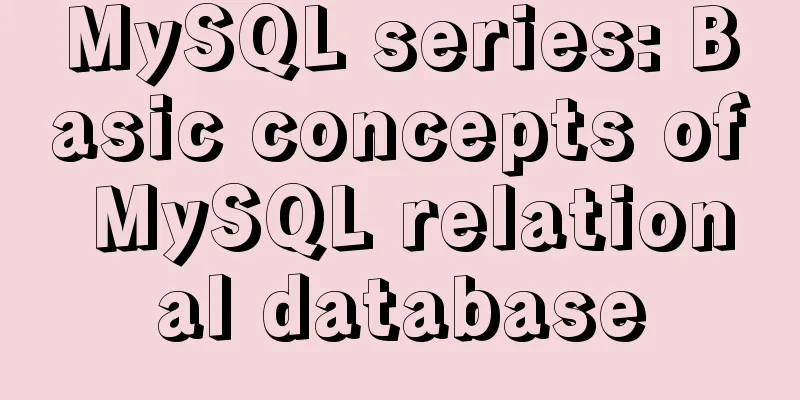MySQL series: Basic concepts of MySQL relational database

1. Basic ConceptsData is a symbolic record that describes things. It refers to identifiable information recorded using physical symbols. 1. Database (DB) refers to an organized and shareable collection of data stored in a computer for a long time. Data should be organized, described and stored according to a certain data model, with low redundancy and high data independence. The system should be easy to expand and can be shared by multiple users. Three basic characteristics of data:
2. Database management system (DBMS) is a set of software specifically used to establish and manage databases, which is between application programs and operating systems. It implements various functions of the database system. It is the core of the database system.
3. The database system consists of:
4. Database system architecture:
5. Structure of the database system
External mode/mode image ensures the logical independence of data and program Internal mode/mode image ensures physical independence of data and programs 6. Model A model is a simulation and abstract expression of real-world characteristics. The data model is an abstraction of the characteristics of real-world data and describes the common content of the data. 2. Development of Database Management Technology
1. Disadvantages of file system management
2. Advantages of Database Management System
3. Relational Database (RDBMS) ConceptA relational database is a collection of all relations that constitute a relational database. A type of database that uses the relational model as the logical model of data and relations as the way to organize data. Its database operations are based on relational algebra.
1. Transaction Multiple operations are treated as a whole Transactions follow ACID properties:
2. ER Model (Entity-Relationship) Entity: Objective things or abstract events that exist objectively and can be distinguished from each other are called entities. In the ER diagram, entities are represented by rectangular boxes, and the entity names are written inside the boxes. Attribute: A characteristic or property possessed by an entity Relationship: A relationship is a collection of associations between data and is an objectively existing application semantic chain. There are connections within entities and connections between entities. The connections between entities are represented by diamond-shaped boxes. Type of contact:
3. History of relational databases
4. Elements of the relational data model Elements of the data model include:
5. Three elements of data
Data extraction, extracting interesting content from a data set.
Entity integrity 6. Constraint
7. Index Copy the data in one or more fields in a table and save them separately, and these need to be sorted and stored in a specific order. 8. Relational operations
9. Data Model
Physical layer: data storage format, that is, how RDBMS organizes files on disk Logical layer: from the DBA's perspective, describes what data is stored and what kind of relationship exists between data View layer: from the user's perspective, describes some data in the DB
Object-based relational model Semi-structured relational model 4. RDBMS Design ParadigmWhen designing a relational database, we must follow different specifications and design a reasonable relational database. These different specifications are called different paradigms. Various paradigms present sub-specifications. The higher the paradigm, the less redundancy the database has. Currently, there are six paradigms for relational databases: the first paradigm (1NF), the second paradigm (2NF), the third paradigm (3NF), the Badesco paradigm (BCNF), the fourth paradigm (4NF) and the fifth paradigm (5NF, also known as the perfect paradigm). The minimum required normal form is the first normal form (1NF). The first normal form that further meets more specification requirements is called the second normal form (2NF), and the remaining normal forms are similar. Generally speaking, a database only needs to meet the third normal form (3NF).
Note: The first normal form (1NF) is the basic requirement for the relational model. A database that does not meet the first normal form (1NF) is not a relational database.
This concludes this article on the basic concepts of MySQL relational database, the opening chapter of the MySQL series. For more information about MySQL relational database, please search for previous articles on 123WORDPRESS.COM or continue to browse the following related articles. I hope you will support 123WORDPRESS.COM in the future! You may also be interested in:
|
<<: Detailed process of using vmware to test PXE batch installation server
>>: How to use CSS attributes to block mouse events (mouse clicks can penetrate upper elements)
Recommend
mysql5.7.17 installation and configuration example on win2008R2 64-bit system
123WORDPRESS.COM has explained to you the install...
How MySQL handles implicit default values
Some students said that they encountered the prob...
js implements single click to modify the table
Pure js implements a single-click editable table ...
Detailed explanation of MySQL covering index
concept If the index contains all the data that m...
Summary of commonly used multi-table modification statements in Mysql and Oracle
I saw this question in the SQL training question ...
Example code for implementing image adaptive container with CSS
There is often a scenario where the image needs t...
Mybatis+mysql uses stored procedures to generate serial number implementation code
Use stored procedures to start transactions when ...
html option disable select select disable option example
Copy code The code is as follows: <select> ...
How to implement a lucky wheel game in WeChat applet
I mainly introduce how to develop a lucky wheel g...
Innodb system table space maintenance method
Environmental Description: There is a running MyS...
Implementation code for saving images to MySQL database and displaying them on the front-end page
Table of contents 1. First, use pycharm to create...
How to implement page jump in Vue project
Table of contents 1. Create a vue-cli default pro...
Detailed explanation of MySQL batch SQL insert performance optimization
For some systems with large amounts of data, the ...
Summarize some general principles of web design and production
<br />Related articles: 9 practical suggesti...
MySQL permission control details analysis
Table of contents 1. Global level 2. Database lev...









